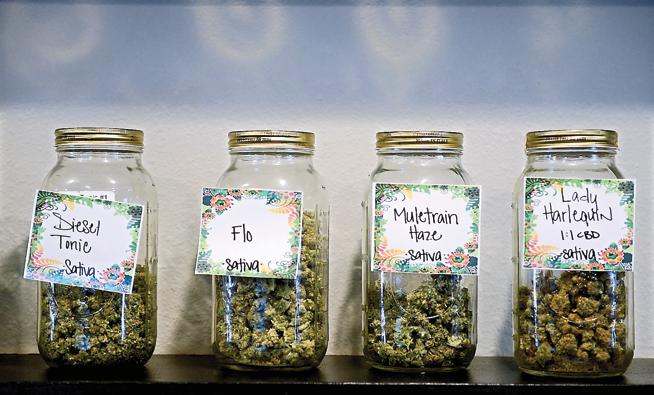Mapping the cannabis genome
CBD might be the story now, Forstmann said, but the headlines of the future have yet to be written as more research is done into the 100 or so other compounds in the canna sativa plant, each with potential benefits of its own.
The wide genetic variance of unexplored compounds could result in thousands of new products, said Nolan Kane, an evolutionary biologist and post-doctoral adviser at the University of Colorado, which is participating in the Cannabis Genomic Research Initiative.
“People are starting to get a handle on some of that, but a lot of it is in its infancy,” he said.
Kane’s lab has so far sequenced the genetics of 600 strains and had data from 148 more donated by a Canadian lab to analyze.
Before legalization, only three different strains had been sequenced, Kane said. “So basically that’s 300 times as much information in the last year in terms of data that’s been generated.”

Kane said collaborations with other departments, such as neuroscience, business and psychology, are beginning to form at CU as well, partnerships that will greatly enhance the understanding of marijuana’s impact on society.
“There’s certainly more people starting to become interested” in conducting research, said Lucy Troup, an assistant professor of cognitive neuroscience at Colorado State University who is conducing research into marijuana’s effect on emotional processing.
Still, funding shortfalls, social stigma and governmental red tape continue to make it difficult to get approval for research projects.
The Obama administration helped this June by eliminating a required review by the Public Health Service for medical marijuana research. But the process still doesn’t always make sense, Troup said.
“Studies require a federally grown and controlled substance to be provided, but users in real life don’t pop down to the feds and say, ‘Can I have an ounce of your best stuff,'” she said.
Eaten, not smoked
The edibles category will also continue to morph in 2016. Now, it accounts for about 7 percent of the total cannabis market, according to a November report from Boulder’s BDS Analytics, and it is dominated by junk food such as candies and cookies.
But there is a small and persistent demand for healthier options, according to industry experts, driven in part by the entry of non-traditional users into the space.
“A lot more older patients are coming in with chronic diseases and the goal to reduce opiate dependence,” said Allyson Feiler, CEO of Green Tree Medicinals, which operates dispensaries in Boulder and Longmont.
The trend toward healthier edibles isn’t new, she said, but rather a return to days when only medical marijuana was legal and the edibles were made to be medicine.
“When I started doing this five and a half years ago, that’s what was being made: a lot more natural options. nut bars, granolas,” Feiler said. But the legalization of recreational products opened the category to big manufacturers, who both grew and evolved the market with lower-cost, higher-sugar options that came to dominate the space.
Though healthful products make up a “very small portion of the recreational space,” the demand in Boulder County is quite high, said Julie Dooley, owner of Denver-based Julie’s Natural Edibles.
“Boulder is my No. 1 city” for sales, she said, despite being home to less than a third of the dispensaries that carry her product. “I do more sales in Boulder and Lyons than I do in Denver.”
Marijuana cocktails, coming to a bar near you?
Feiler said she has noticed a trend away from edibles due to “inconsistency and variation in digestion” — a problem widely acknowledged in the industry.
“Imagine you go to the store and buy a six-pack of beer, take it home and every bottle gets you a different kind or amount of drunk,” said Dooma Wendschuh, co-founder of Denver-based consumer products startup Ebbu. “One bottle makes you giddy, one makes you depressed, one gets you wasted the other doesn’t seem to have any alcohol at all — it’s not reliable.”
That lack of predictability limits market potential for edibles, Wendschuh said, arguing that bars and restaurants would never serve a legal product they couldn’t guarantee.
That’s the market Ebbu is going after with what will be its flagship product: distilled marijuana and hemp oil that can be used in edibles and beverages — something Wendschuh thinks will eventually compete with alcohol.
Useful weed resources
Strain reviews: Check out our marijuana reviews organized by type — sativas and sativa-dominant hybrids, ditto with indicas.
Favorite strains: 25 ranked reviews from our marijuana critics
NEW: Get podcasts of The Cannabist Show.
Subscribe to our newsletter here.
Watch The Cannabist Show.
The demand is there: Ebbu has raised $7 million since April, in addition to $2 million in seed funding from 2014.
Also driving innovation, at least in part, will be legislation.
The Colorado Marijuana Enforcement Division in October enacted a rule, to take effect in October 2016, that will require ‘THC’ to be stamped on the products themselves, unless they are single-serving sizes — which are costly to produce and don’t sell well.
“To some degree, that’s the tail that’s going to wag the dog because everything you make is going to have to be imprinted in some way,” said Nancy Whiteman of Boulder-based Wana Brands. “You might have a great idea for a salsa, but you’re never going to be able to imprint that.
“It’s an interesting thing to see how regulatory requirements will end up impacting product innovation.”
Shay Castle: 303-473-1626, castles@dailycamera.com, @shayshinecastle
Updated Dec. 30 at 1:17 p.m. The following corrected information has been added to this article: Because of a reporter’s error, the role Ebbu has in manufacturing infused products was misreported. Ebbu makes distilled hemp and marijuana oil that can be used in beverages and edibles, but does not make those products themselves. Also, the job title for Dooma Wendschuh was misreported. He is the co-founder of Ebbu.
